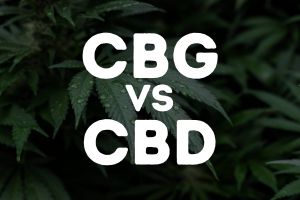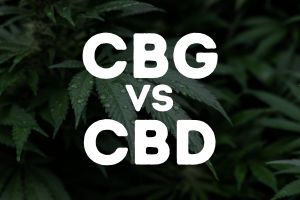CBG vs CBD: Understanding the Difference
Posted by Tweedle Farms on Dec 8th 2023

CBG vs CBD: Understanding the Key Differences Between Cannabigerol and Cannabidiol
In the ever-expanding landscape of cannabis-derived compounds, two cannabinoids have risen to the forefront of scientific and public interest: Cannabigerol (CBG) and Cannabidiol (CBD). As the therapeutic potential of cannabinoids continues to be explored, discerning the nuanced disparities between CBG and CBD (and the plants from which they are derived, CBG flower and CBD flower) becomes imperative for those seeking holistic wellness alternatives.
CBG vs CBD: Chemical Structure and Biosynthesis
CBG and CBD, both derived from the hemp plant (specifically CBG flower and CBD flower), share a common ancestor in Cannabigerolic Acid (CBGA). However, their divergence occurs in the enzymatic conversion process. While CBG is the direct precursor to several other cannabinoids, including CBD, it is noteworthy that CBG is generally present in much lower concentrations in most cannabis strains compared to CBD.
The low concentration of CBG in hemp flower arose as a pain point for those in the hemp industry when CBG began gaining popularity in 2019. Fortunately, breeders had anticipated this need and were able to release White CBG, the industry’s first strain of high CBG flower in time for the 2019 and 2020 growing seasons.
CBG: The Precursor and Potent Player
CBG, often hailed as the "mother" or "stem cell" of cannabinoids, boasts a relatively small presence in the majority of cannabis plants due to its conversion into other cannabinoids like THC, CBD, and CBC. Because of this, it was truly incredible when the great minds at Oregon CBD first released White CBG, a strain of CBG flower that is dominant in CBG. So dominant, in fact, that it contains barely any other cannabinoids at all.
Known for its potential therapeutic properties, CBG stands out for its neuroprotective and possible antibacterial attributes, positioning it as a potent cannabinoid deserving of scientific attention and exploration, and because of its wide availability due to the omnipresence of CBG flower, this exploration is able to take place!
CBD: The Versatile Cannabinoid
On the other hand, CBD (and its all natural form, CBD flower) has gained widespread attention for its diverse potential applications in wellness. Unlike THC, CBD is non-intoxicating and does not induce psychoactive effects, making it an appealing option for those seeking the benefits of cannabis without the "high." There was a time, however, when CBD flower could not hold a candle to the quality of THC flower, but fortunately, that time has passed.
Hemp CBD flower is now being cultivated across the world by a vast number of master growers, resulting in flower that can stand on its own in terms of structure, aroma, flavor, and potency.
CBG vs CBD: Differing Mechanisms of Action
While both CBG and CBD exhibit promising therapeutic potential, their mechanisms of action diverge, contributing to their unique effects on the body's endocannabinoid system (ECS). CBG interacts with the ECS by influencing receptors such as CB1 and CB2, potentially modulating neurotransmitter release and exhibiting neuroprotective properties.
On the other hand, CBD's interaction with the ECS involves indirect modulation of cannabinoid receptors, affecting serotonin receptors and other non-cannabinoid receptors. This differential interaction contributes to CBD's reported effects on anxiety, pain perception, and inflammation.
CBG vs CBD: Legal Status and Accessibility
In terms of legal status, both CBG and CBD sourced from CBG flower and CBD flower, respectively, are legal in many jurisdictions, thanks to legislation differentiating hemp from marijuana based on THC content. This legal distinction has led to the widespread availability of CBD products and an emerging market for CBG-infused offerings.
The Verdict
In the realm of cannabinoids, CBG and CBD stand as distinct compounds with their own unique characteristics and potential therapeutic applications. While CBG's emerging presence in research highlights its promise in various medical fields, CBD's versatility and established market presence continue to make it a sought-after option for wellness enthusiasts.
In essence, understanding the differences between CBG and CBD opens doors to a nuanced exploration of cannabinoids, offering individuals an informed approach to incorporating these compounds into their wellness routines. As research progresses, the potential synergy between CBG and CBD in combination therapies may further expand the horizons of cannabinoid-based treatments, providing new avenues for holistic well-being.



